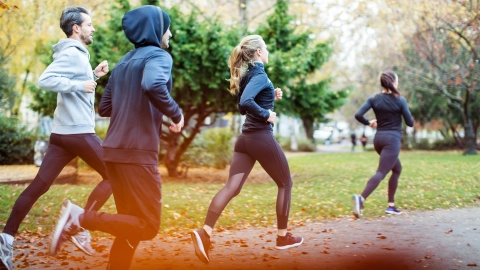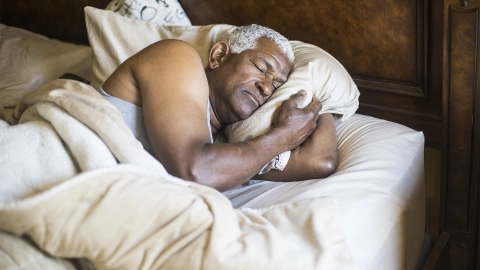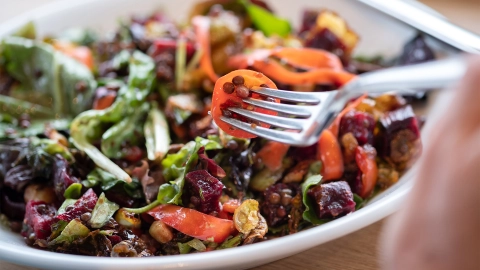Healthy living Healthy aging – with a balanced diet and plenty of exercise
With age, the metabolism and the ratio of muscle to body fat change. The energy requirement reduces and the body loses mobility and strength. This is why it needs regular exercise and a balanced diet to stay fit and healthy in older age.
At a glance
- With age, the metabolism changes and the body’s energy needs decrease.
- However, its requirement for essential nutrients, vitamins and minerals changes only slightly.
- A varied diet and regular exercise can help people maintain good health.
- Eating well in older age not only means eating a varied diet, but also taking account of individual preferences and requirements.
- Health-promoting activities don’t need to be complicated. Regular movement as part of daily life – including walking, cycling or climbing the stairs – can make a big difference.
Note: The information in this article cannot and should not replace a medical consultation and must not be used for self-diagnosis or treatment.

Why are a healthy diet and regular exercise so important?
By eating a balanced diet and getting regular exercise, people can play a big part in helping themselves remain fit and healthy as they age. Some age-related health risk factors and illnesses can be prevented or at least delayed in this way.
Exercise keeps the body fit, strengthens bones and joints and protects the cardiovascular system. It promotes mobility and balance. Physical activity also benefits mental health. Which, in turn, improves a person’s general well-being. This creates a good basis for a healthy and independent life well into older age.
What can make healthy eating difficult in later life?
Eating a varied, balanced diet is particularly important to ensure that the body is supplied with sufficient nutrients and stays fit into older age. The resting metabolic rate, i.e. calorie consumption at rest, decreases with age. However, the need for nutrients, vitamins and minerals remains almost as high as in younger people – and in some cases even increases. It is therefore important to reduce daily calorie intake in later life while still ensuring a good supply of nutrients. In practical terms, this means consuming less food but ensuring that the food consumed is balanced and varied.
Important: The body needs fewer calories as it ages. A person aged 65 needs, on average, 200 to 300 fewer calories per day than a person aged 25. This corresponds to half a bread roll filled with cheese, a 250 g pot of fruit yogurt or a small portion of fries with mayonnaise.
Problems
Older people may find it difficult to eat a balanced diet if they are no longer able to tolerate certain types of food. Chewing and swallowing disorders can also cause problems – for example, some people are no longer able to properly chew nuts, apples or other hard foods.
Older people often find high-fiber foods and wholegrain items difficult to chew or to digest and avoid them as a result. They frequently find wholegrain products made from finely ground flour (e.g., bread or bread rolls) easier to tolerate than coarse-grain items. It is advisable to try these because wholegrain products are very rich in nutrients.
In addition, people’s appetites often wane with age, as does their desire and strength to prepare their own meals. This means that older people may end up having too limited a diet and no longer getting all the nutrients they need. This can result in malnutrition.
Malnutrition means that the body is not getting enough of certain minerals and vitamins (micronutrients) due to a permanently restrictive diet. This is particularly prevalent among younger seniors. This age group is also more likely to become overweight, as they eat more calories than they need.
Malnutrition also means not eating enough calories to meet your body’s requirements. This is common among people of very advanced age and can cause them to be underweight.
How to eat well in later life
The following ideas and tips provide some general guidance on how to eat well in later life:
- When shopping, choose foods that are varied, regionally produced, in season and as fresh as possible.
- Varied means that the items are from a range of food groups (cereals, fruit and vegetables, dairy products, meat and fish, oils and fats).
- Cooked food is easier to digest. However, it should preferably be briefly steamed or lightly braised rather than boiled or roasted for a longer period so that the food remains rich in minerals and vitamins.
- 5 a day: Five portions of fruit and vegetable a day supply the body with the most important nutrients. Examples of portions include a handful of freshly prepared mixed vegetables, a handful of salad, a handful of freshly prepared legumes, a piece of fruit or a glass of fruit juice.
- Drink 1.5 liters of fluid per day – water and unsweetened fruit and herbal teas are ideal for quenching thirst. Fruit juice spritzers comprising one part juice and three parts water are another good way to keep the body hydrated. Keeping bottles and glasses clearly visible and easily accessible around the home can help people ensure that they drink enough each day.
- Eat fewer foods that contain high levels of sugar, salt and animal fats – for example, ready meals, fast food, sausages and sweets.
- Quark (with or without herbs) and cream cheese can replace high-fat sandwich fillings (like salami or meat paste) and should be an everyday part of people’s diets, together with other dairy products because they provide calcium, protein and B vitamins.
- When eating bread, rice and pasta, wholegrain varieties should be chosen where possible, as these contain high quantities of vitamins, fiber and minerals and keep people full for longer.
- Wholegrain pasta and rice need a little more time when cooking to soak up water and become softer.
- When it comes to wholegrain bread, there are now many products that are made from finely ground flour, which is more palatable and does not cause problems when chewing or swallowing.
- Make a date with friends, family or neighbors to cook or dine together – preparing and eating food with other people is more fun.
The food pyramid provided by the Federal Center for Nutrition (BZfE) and the food circle provided by the German Nutrition Society (DGE) offer guidance on healthy eating.
People who don’t enjoy eating alone may be able to have lunch at a senior citizens’ center, for example. For those who want to eat at home but no longer cook for themselves, healthy mobile meals (“meals on wheels”) can be ordered and delivered to their door.
How much exercise is good for the body in later life?
Your back hurts and your hips are giving you trouble – there are so many excuses for sitting on the sofa. However, these are actually the perfect reasons to get up off that sofa and do more exercise and sport. This is because aches and pains are often – though not always – the body’s way of letting us know that it has been moving incorrectly, that too much strain has been put on one side and not the other, or that it simply needs more physical exertion.
Exercise is healthy – it halts muscle wasting, strengthens the body and boosts overall well-being. Exercise also reduces the risk of depression.
In addition, regular physical activity strengthens the cardiovascular and immune systems and trains the sense of balance, thereby reducing the risk of accidents and falls.
Video How can the elderly prevent falls?
The video below explains what elderly people can do to prevent falls during everyday life.
This and other videos can also be found on YouTube
Watch nowThe privacy policy indicated there applies.
Numerous studies have confirmed the positive effects of exercise on health in later life. They also show that people don’t need to do strenuous sporting activities – regular movement as part of everyday life can already have plenty of benefits. Often, simply walking regularly can prove beneficial. Taking the stairs instead of the elevator whenever possible, getting off public transport two stops earlier and keeping pace with the grandchildren now and again can all make a big difference. Anyone who wants to do more should choose sports that are easy on the body while also improving endurance, such as hiking, swimming, dancing, yoga, aerobics or walking.
Germany’s “National Recommendations for Exercise and Promotion of Physical Activity” offer guidance on health-promoting physical activities, including those for people aged 65 and older:
- Do at least 150 minutes of moderate exercise per week – for example, 30 minutes of fast walking, cycling or swimming five times a week.
- Alternatively, do at least 75 minutes of higher-intensity exercise per week – for example, 15 minutes of running, fast cycling or fast swimming five times a week.
- Or, combine moderate and high-intensity exercise over the week – for example, 30 minutes of fast walking, cycling or swimming three times a week plus 15 minutes of running, fast cycling or fast swimming twice a week.
- Also do some muscle-strengthening exercise such as aerobics or strength training on at least two days each week.
- Where possible, avoid sitting down for long periods and take short breaks to stretch the legs – for example, by standing up while working or going for short walks.
Where can further information be found about health in later life?
The Federal Center for Health Education (BZgA) provides more tips on diet, exercise and other topics relating to health in later life on the websites “Gesund & aktiv älter werden” and “Älter werden in Balance” (in German).
The National Action Plan’s internet portal “IN FORM – Deutschlands Initiative für gesunde Ernährung und mehr Bewegung” offers articles and tips on healthy eating and exercise as well as a wide range of recipes (in German).
The Federal Ministry of Food and Agriculture (BMEL) publishes a magazine called “Gutes Essen” (“Good Food”) with information and tips on healthy eating, as well as recipe ideas for senior citizens (in German). The magazine is published several times a year and subscription is free.
There are also plenty of recipe ideas (in German) to suit a wide range of palates in the recipe database of the German Nutrition Society (DGE) (“Fit im Alter” (“Fit in Older Age”)).
- Bundesministerium für Ernährung und Landwirtschaft (BMEL). 66 Tipps für ein genussvolles und aktives Leben. 6. Auflage. 03.2019.
- Bundesministerium für Gesundheit (BMG). Ratgeber zur Prävention und Gesundheitsförderung. 9. aktualisierte Auflage. 01.2016.
- Bundeszentrale für gesundheitliche Aufklärung (BZgA). Gesund und aktiv älter werden. Ernährung. Aufgerufen am 04.03.2022.
- Bundeszentrale für gesundheitliche Aufklärung (BZgA). Menschen in Bewegung bringen. 03.2019.
- Bundeszentrum für Ernährung (BZfE). Ernährungspyramide: Was esse ich? Aufgerufen am 04.03.2022.
- Deutsche Gesellschaft für Ernährung (DGE). Essen und Trinken im Alter. DGE-Praxiswissen. 2. Auflage. 04.2014.
As at:






